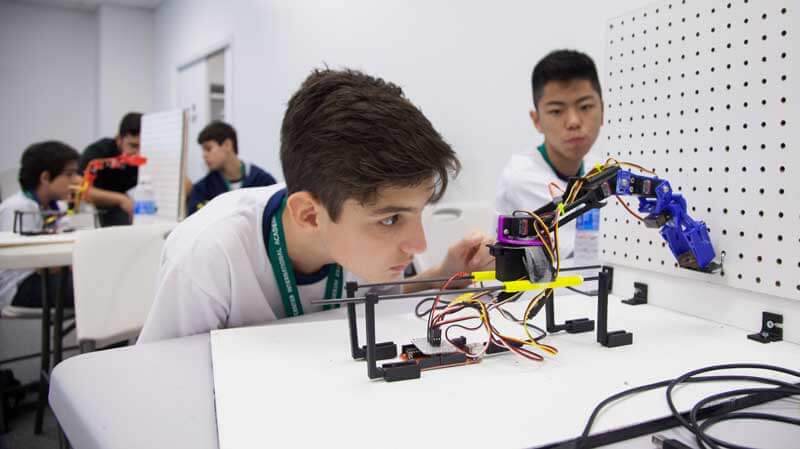We live in a global village where the use of technology is inevitable regardless of the field of life you are in, especially if you are in academics. The use of cutting edge technology has taken over archaic methods of teaching and learning, where laptops replace books and reference materials are substituted by digital logs. Today’s society has quickly embraced the modern education system, both students and parents believe that this new method is much convenient and hassle-free. A significant number of people including both youngsters and adults are also aiming for virtual education, which is entirely technology based.
Let us analyze top seven key concepts in which technology can be used for pedagogical purposes:
1. Promoting active learning
In a productive learning environment, students are actively engaged with the learning material. It is largely believed that technology-based learning could be passive, but in reality, it is highly interactive allowing students to engage at different levels. As opposed to the conventional classroom where some students are taking notes while others are conveniently napping, technology-focused classroom engages all learners. Especially in virtual learning, the limited number of students makes it is possible for professors to keep an eye on less active participant and engage them at earliest. Also, keeping notes in a cell phone or laptop is much easier than managing papers, allowing learners to keep backlogs as well.

2. Keeping it real
This model enables mentors to use actual examples from life rather than teaching old theories from the books, making it much more tangible for learners. For example, the classroom where a teacher uses Google maps on the internet to show some place will be able to engage pupils much more vigorously than a classroom where a map is shown merely on paper. The connection with real-life instances makes it intriguing for students thus enhanced participation is noticed in most experiences.
3. Modelling and simulation
Remember the magical feeling of stepping into the galaxy when you visited the planetarium in your childhood or playing a video game in your teens? Modern classroom uses advanced technology that allows learners to be virtually present in the system by viewing the exact model on their screen, something that would be impossible to understand by looking at a chart or mere theoretical explanation. Nowadays sophisticated software tools are available that are used to create a virtual prototype of a model predicting how they may perform in the real physical world.
4. Interactive sessions
You don’t need to wait in queue or be in a paid virtual e-learning classroom to discuss things. Modern day technology has made it possible to discuss your queries digitally from anywhere in the world. You just need to create online groups, pages or find relevant communities to discuss your questions and views. These interactive sessions allow learners to debate their ideas, which they may not do in the classroom because of the limited time or lack of peer’s interest. Mostly in e-learning students can engage with their mentors even after the lessons are over, therefore allowing them to not only deepen their understanding but also to learn a little extra. In many instances, online debates and discussions have helped people discovering new friends of the same interest and caliber.
5. Working groups
This could be an effective way to arouse critical thinking, analysis, and decisiveness in students at the same time actively involving them in the learning process. Working groups have been popular in the modern education system and are part of each course especially the ones with greater complexity. In schools, working groups are generally assigned by teachers or at times; students are given an option of choosing their work partners.
Unlike conventional classrooms where working groups are made and supervised by teachers, technology-focused education provides an opportunity for likeminded people to come closer on their own. These e-working groups have proven to be more efficient and democratic than their conservative counterparts as the members may choose each other on their own, thus enhance each others’ efficiency and productivity. In addition, it also results in better ownership of the project or assignment, since they have chosen the subject their selves. The purpose of the working group in each mode of study is the same, motivation and augmented productivity.

6. Coaching
In modern education, the teacher’s role is expanded. They don’t simply walk out of the class after delivering a lecture; their responsibilities now include coaching students that requires much more effort and time. The classroom curriculum demands that they guide and support students on each step, and for that, they at time require special training sessions. In today’s technological era, a teacher has to be well equipped with the modern tools of teaching especially computer knowledge and other related information. A good coach would know how to guide their pupil in need and direct them toward a source that will help them produce quality work.
For example, if a student with beginner writing skills require help will be helped until they are able to write essays as eloquent as provided by custom assignment writing services by Aussie. As a coach, students seek not only such guidance but look forward to their feedback in order to improve the outcome of their assignments or tasks. In an e-learning environment, learners have an extra edge. They don’t have to wait to reach their alma mater to ask questions; instead, they can quickly send a notification for a chat. The fewer number of students also make it convenient for mentors to attend and coach each student separately in a virtual learning environment. In each case though, coaches improve the skills and abilities of their students by spending their time and energy.
7. Assessment is the key
In an active learning environment, students learn through technology and engage in healthy discussion on forums creating masterpieces. Yet their achievements need to be thoroughly reviewed by mentors to see whether their efforts have yielded required results or not. The latest study reveals that teachers who actively participate in activities with their students are trusted more by pupils than those who assign and leave. This guidance enables students to acquire critical thinking and rationalization they need to complete their tasks. Additionally, mentors who are well acquainted with technology are considered smart by their class than those who depend mainly on books. In many institutions, high technology is now part of the course curriculum, so the majority of course teachers have hi-tech knowledge.
The purpose of modern education is to equip well students with the modern tools of technology enabling them to become a productive member of this hi-tech society. In this entire process of developing active learners in conventional or e-learning platforms, teachers play the core role. They mentor, discuss, and provide feedback on the entire process of learning, enabling pupils to develop a deeper understanding of complex ideas. It is also observed that classrooms that employ the latest technology in the process of learning yield better results. Also, it helps youngsters use technological tools and gadgets to their educational purposes rather than wasting time on non-educational activities.
About the author:
Crystal Roman is a guest professor in virtual universities on a regular basis. Her articles are regularly published in e-magazines where she actively advocates the use of modern technology in today’s classrooms. During her career, Roman has taught in elementary, middle, and high schools, and she has recently had the opportunity to join a virtual college offering online and offline help to more challenging students. Crystal Roman lately helped her e-college to develop an e-discussion forum allowing students to discuss a topic from all over the world.


No comments:
Post a Comment